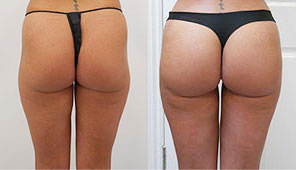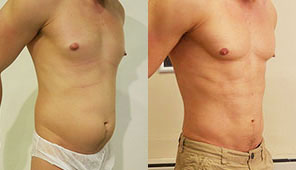Jowling in the lower face is one sign of aging that doesn’t go away easily. When the skin around the jawline begins to sag and droop due to age or weight fluctuations, jowling can occur. This can cause the chin to appear weak or undefined and make the face look much older than it actually is. Fortunately, there are several ways to tackle this common problem.
As the ultimate facial rejuvenation surgery, the facelift is the gold standard for lifting and tightening troublesome jowls. And, for those looking to avoid surgery, there are non-surgical options like Ultherapy and dermal fillers.
The Hamlet Clinic in Highgate, London, is proud to offer patients a variety of treatments to help reduce the appearance of prominent jowls. And whether you are looking for non-surgical treatments or more invasive solutions, Dr Hamlet and his team can help you achieve the results you desire. Call (0207) 127 4377 to book a personal consultation at The Hamlet Clinic, or complete a simple contact form for more scheduling information.
The Facelift: Say Goodbye to Prominent Jowls
The facelift, or rhytidectomy is a consistently popular anti-aging procedure, evidenced by its consistent rankings in the top 5 aesthetic procedures performed every year. (1) For those who are looking for a permanent solution to signs of aging, facelift surgery is the choice procedure. During the procedure, excess skin is removed and underlying tissues are tightened, resulting in a more youthful appearance. Depending on the patient’s goals, a surgeon may combine other facial procedures, such as eyelid surgery or other facial aesthetic treatments, with the facelift for even better results.
Types of Facelift
A full range of facelift techniques can help patients fight the signs of aging:
- SMAS Facelift – Addresses the underlying muscles as well as the skin .
- Limited Incision Facelift – Involves a shorter incision for a less involved recovery.
- Deep Plane Facelift – Works to change tissues on the deepest planes of the face.
- Facelift with Neck Lift – Combines the lifting and tightening effects of the facelift and the neck lift with a longer incision around the ears and down the neck.
Am I a Good Candidate for a Facelift?
Candidates for facelift surgery are in good general health with no conditions that could affect their surgery or recovery. Patients looking to address prominent jowls may be ideal candidates for a surgical facelift, as it lifts and smooths lax skin in the lower face.
What is Facelift Surgery Like?
Preparation
Before a facelift procedure, a patient will receive personalized instructions to help them plan for surgery. One general rule for all facelift surgeries is that the patient must quit smoking up to four weeks before the procedure, and well into their recovery. Because the surgery involves the use of general anesthesia, patients are usually advised to get a lift with a friend or family member to and from their appointment.
Facelift Procedure
After administration of anesthesia, the surgeon makes small incisions in inconspicuous locations on the face – usually around the contour of the ears and the hairline. They then lift and reposition the underlying tissue and skin to create a more youthful, attractive appearance. Once they have removed excess skin and achieved the desired result, they close the incisions with sutures.
In the facelift procedure’s recovery period, the patient receives a compression garment to wear to aid their healing. They are also given specific instructions to ensure they heal in the fastest, most comfortable way possible. At this time, they avoid strenuous activities and take some time off work to recuperate.
Results
Patients may notice a difference in their facial contour immediately after their procedure. Although there is postprocedural bruising and swelling, these can be mitigated with prescription medications until discomfort subsides. Results of a facelift may continue to settle and improve for up to three to six months following treatment.
Non-Surgical Therapies for Jowls
Non-surgical therapies such as Ultherapy and dermal fillers provide an excellent way to reduce the appearance of jowls without undergoing surgery.
About Ultherapy
Ultherapy, or the “non-surgical facelift” is a non-invasive ultrasound therapy that lifts and tightens sagging skin.
- Uses focused sound waves to target deep tissue layers.
- Stimulates collagen production.
- Helps to lift and firm the skin.
- Results in less prominent jowling.
- Restores a smoother, more youthful appearance.
How Does Ultherapy Work?
Ultherapy utilizes ultrasound technology to trigger a process called neocollagenesis (the production of new collagen) in the deeper layers of the skin. It is an excellent option for patients who want to take years off their face without undergoing a traditional facelift procedure. One of the best features of Ultherapy is its ability to prevent new signs of aging and restore natural, youthful looks treatment after treatment. (2)
Dermal Fillers
Dermal fillers are injectable treatments that restore volume and structure to the face. They include:
Certain fillers are also a great option for reducing prominent jowls. Fillers work by adding volume to the area, which helps to smooth out wrinkles and give the face a lifted, contoured look. Results are immediate and can last up to two years.
Sculptra for Jowls
The champion in the fight against facial jowling is Sculptra. It’s a poly-L-lactic acid (PLLA) dermal filler that acts as a tissue volumizer. PLLA is a synthetic polymer substance composed of tiny microparticles that helps to smooth and fill in gaps in facial tissues. (3) What’s more, Sculptra is one of the longest-lasting fillers available, lasting up to two years!
Do Fillers and Ultherapy Require Anesthesia?
If you’ve chosen to undergo Ultherapy or dermal filler treatments, you will not need to receive general anesthesia. The injections or ultrasound energy used during these treatments will be administered with precision and care with only local numbing, where required.
Personal Consultation
Dr Hamlet is an experienced and knowledgeable surgeon who specializes in face and body rejuvenation. He will take time to get to know you and your goals at your consultation appointment so that he can create a personalized plan that is tailored to your needs. He is dedicated to helping his patients achieve their desired facial contours while preserving their natural, youthful looks. Our friendly and knowledgeable staff will be happy to answer any questions you may have.
If you are unhappy with the appearance of your jowls and would like to explore your options, please call our office at (0207) 127 4377 or fill out an inquiry form to schedule a consultation at The Hamlet Clinic, Highgate.
Getting Rid of Jowls: What About Recovery?
The recovery process will depend on which procedure you’ve chosen. Surgical facelifts require a longer recovery time, and may require up to two weeks away from work to rest at home. Non-surgical treatments like Ultherapy do not require a long recovery period and have minimal aftercare requirements. With fillers, you will even be able to resume your usual activities with care the same day as your procedure!
Learn more about surgical recovery and more by reading The Hamlet Clinic blog.
Cost of Jowl Reduction Treatments in London
Dr Hamlet has helped thousands of patients restore their youthful facial contours, reduce their jowls and look their very best for any occasion! Contact us to learn if a facelift, Ultherapy, or dermal fillers are right for you.
Arrange your visit to Highgate Private Hospital. Telephone (0207) 127 4377 to speak to us and get a one-on-one meeting with leading surgeon Dr Hamlet. Find out about financing your procedure here.
FAQS
What is the difference between a facelift and Ultherapy?
A facelift is a surgical procedure that requires an incision and repositioning of the underlying tissues and skin. Ultherapy is a non-surgical treatment that uses ultrasound energy to stimulate collagen production in the deeper layers of the skin. Ultherapy does not involve cutting or repositioning the skin.
How much is a facelift in London?
Due to the fact that facelifts are highly customized plastic surgery procedures, facelift pricing is determined on a case-by-case basis. Once you and your surgeon have agreed on your treatment preferences, you will receive a personalized estimate for your treatment.
Can a facelift get rid of wrinkles?
Although facelifts don’t get rid of wrinkles per se, they can tighten and reposition the underlying tissues, and remove excess skin, drastically reducing the appearance of wrinkles.
Can dermal fillers reduce jowls?
Jowls are challenging to reduce, however, PLLA-based fillers like Sculptra can be used to minimize their appearance on the face.
References
- Yang AJ, Hohman MH. Rhytidectomy. PubMed. Published 2022. Accessed April 26, 2022. https://www.ncbi.nlm.nih.gov/books/NBK564338/#:~:text=The%20first%20documented%20facelift%20was
- Fabi SG, Joseph J, Sevi J, Green JB, Peterson JD. Optimizing Patient Outcomes by Customizing Treatment With Microfocused Ultrasound With Visualization: Gold Standard Consensus Guidelines from an Expert Panel. Journal of drugs in dermatology: JDD. 2019;18(5):426-432. https://pubmed.ncbi.nlm.nih.gov/31141851/
- Buck, D. W., Alam, M., & Kim, J. Y. S. (2009). Injectable fillers for facial rejuvenation: a review. Journal of Plastic, Reconstructive & Aesthetic Surgery, 62(1), 11–18. https://doi.org/10.1016/j.bjps.2008.06.036






